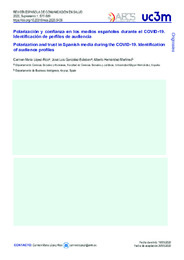Please use this identifier to cite or link to this item:
https://hdl.handle.net/11000/34693Full metadata record
| DC Field | Value | Language |
|---|---|---|
| dc.contributor.author | López Rico, Carmen María | - |
| dc.contributor.author | González-Esteban, José Luis | - |
| dc.contributor.author | Hernández Martínez, Alberto | - |
| dc.contributor.other | Departamentos de la UMH::Ciencias Sociales y Humanas | es_ES |
| dc.date.accessioned | 2025-01-16T18:40:14Z | - |
| dc.date.available | 2025-01-16T18:40:14Z | - |
| dc.date.created | 2020 | - |
| dc.identifier.citation | Revista Española de Comunicación en Salud 2020, Suplemento 1, S77-S89 | es_ES |
| dc.identifier.uri | https://hdl.handle.net/11000/34693 | - |
| dc.description.abstract | Introducción: Durante la crisis sanitaria del COVID-19 la información en los medios de comunicación se ha centrado fundamentalmente en este asunto y el interés de los ciudadanos también ha ido aumentando al respecto. Objetivo: Este trabajo muestra los perfiles de los usuarios españoles en cuanto al consumo de información durante el confinamiento. Metodología: Para ello se ha realizado una encuesta online que fue pionera en el momento de su lanzamiento, lo que nos ha permitido obtener una muestra significativa. La metodología establecida para la gestión de datos se ha llevado a cabo contando usuarios únicos, se han utilizado técnicas de machine learning y el modelo affinity analysis se ha utilizado para descubrir las relaciones de co-ocurrencia entre los elementos. Resultados: De esta forma, hemos podido determinar qué medios han sido más confiables para los ciudadanos a la hora de informarse sobre el coronavirus y si hay una correlación en cuanto a los medios que consumen entre sí. Conclusiones: Definitivamente, se han podido establecer co-ocurrencias entre los usuarios que confían en un medio determinado y otros medios que también son de su confianza y que tienen una tendencia ideológica similar. | es_ES |
| dc.description.abstract | Introduction: During the COVID-19 health crisis, the information in the media has focused mainly on this topic and the interest of citizens has also increased in this regard. Objective: This work shows the profiles of the Spanish users regarding the consumption of information during confinement. Methodology: For this, an online survey was carried out that was pioneering at the time of its launch, which has allowed us to obtain a significant sample. The methodology established for data management has been carried out by counting unique users, machine learning techniques have been used, and the affinity analysis model has been used to discover co-occurrence relationships in the items. Results: In this way, we have been able to determine which means have been most reliable for citizens when it comes to learning about the coronavirus and whether there is a correlation in terms of the means they consume between them. Conclusions: Definitively, co-occurrence has been established between users who trust a certain medium and other means that are also trusted and they have a similar ideological trend. | es_ES |
| dc.format | application/pdf | es_ES |
| dc.format.extent | 13 | es_ES |
| dc.language.iso | spa | es_ES |
| dc.rights | info:eu-repo/semantics/openAccess | es_ES |
| dc.rights | Attribution-NonCommercial-NoDerivatives 4.0 Internacional | * |
| dc.rights.uri | http://creativecommons.org/licenses/by-nc-nd/4.0/ | * |
| dc.subject | media consumption | es_ES |
| dc.subject | consumo de medios | es_ES |
| dc.subject | COVID-19 | es_ES |
| dc.subject | desinformación | es_ES |
| dc.subject | infodemia | es_ES |
| dc.subject | polarización política | es_ES |
| dc.subject | información sanitaria | es_ES |
| dc.subject | disinformation | es_ES |
| dc.subject | infodemic | es_ES |
| dc.subject | political polarization | es_ES |
| dc.subject | health information | es_ES |
| dc.subject.other | CDU::3 - Ciencias sociales | es_ES |
| dc.title | Polarización y confianza en los medios españoles durante el COVID-19. Identificación de perfiles de audiencia | es_ES |
| dc.type | info:eu-repo/semantics/article | es_ES |
| dc.relation.publisherversion | https://doi.org/10.20318/recs.2020.5439 | es_ES |

View/Open:
5439-Texto del artículo-9400-2-10-20200716.pdf
584,13 kB
Adobe PDF
Share:
.png)
